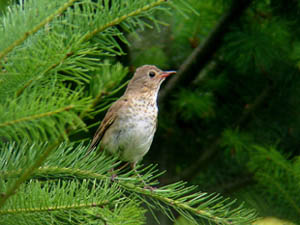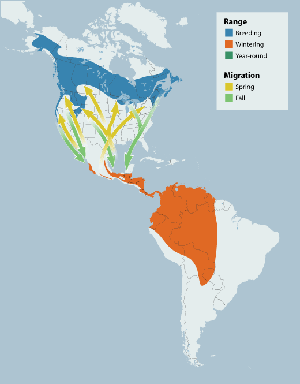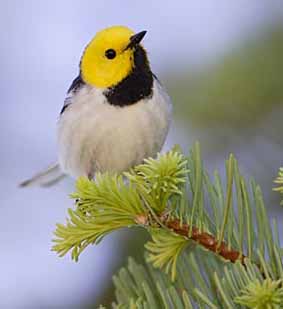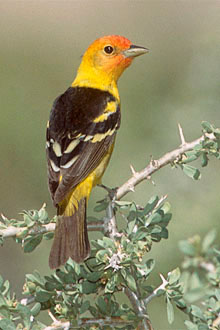Sierra Nature Notes, Volume 5, May 2005
Partners
in Protection
by Rachel Mazur, Wildlife Biologist
Sequoia and King's Canyon National Parks, California
 |
 |
| Top: Swainson's
Thrush
© Greg
Gillson Bottom: Migration map. Arrows represent general migration routes. The arrows do not necessarily link specific breeding and wintering grounds. Map Boreal Songbird Initiative |
On July 31, Sequoia and Kings Canyon National Parks (SEKI) completed a two-year project titled “Partners in Protection: A Cooperative Approach to Conserving Migratory Birds.” The project had three main components - education, biological monitoring, and international exchange. For the education component there were public, bilingual bird walks, international Migratory Bird Day celebrations (May 8), and bird talks for visitors and employees. The monitoring aspect involved peregrine falcon monitoring, the re-establishment of two bird banding stations and two Breeding Bird Survey routes, and monitoring for willow flycatchers in a remote backcountry area.
Probably the most exciting aspect of the program was the international component. Migratory birds present a real conservation challenge. They survive winter by heading to warmer climates having plentiful food. Come spring, they return to the breeding and nesting grounds that are best for them. This is their season of song, when they call to mates and announce their territories. If habitat is damaged in either place - or at important stopping points between - the birds are in trouble.
Several songbirds that we think of as belonging to the Sierra make their way to Central America for the winter. Hermit and Yellow-rumped warblers, Swainson’s thrushes, and the colorful Western tanagers fly there. The brilliant, indigo-hued Western bluebirds winter in Mexico. It's so much fun to see - or hear – which bird just got back and think about where they’ve been. Birding is such a great hobby. You can do it anywhere, it’s free, and you don’t have to be an athlete. Do it alone or make it a social event
We felt that the only way to truly work to conserve migratory birds was to have a connection between their breeding and wintering grounds, and the way we did this was by connecting people. In 2001, we implemented the project with one National Park Service biological technician, Chris Dodge, and one intern from Nicaragua, Salvadora Morales. In 2002, we hired two interns, Alexis Cerezo and Miguel Ramirez - both from Guatemala.
Each year there was one individual who was bilingual and one who spoke only Spanish. Our reasoning was to allow the latter individual to learn English while encouraging SEKI staff to learn Spanish. Not only did that happen, but they also learned about each other's cultures, food, and even local dance steps. Together, the interns provided SEKI with over 1,500 hours of work.
 |
| Hermit Warbler (Dendroica
occidentalis) Sierra County, CA © Mike Danzenbaker |
All three interns were biologists and therefore brought with them a wealth of knowledge about the birds' wintering grounds as well as knowledge about monitoring techniques. They left us with some of that knowledge while bringing home other techniques, refining sampling designs, and a knowledge of the birds' breeding habits and songs. Through visits to other projects in California, the interns also learned about shorebird and owl monitoring.
In order to make this project happen, we involved many people and many partnerships. Within SEKI, the Division of Natural Resources provided supervision, logistics, and technical assistance. Interpreters provided training and oversight for the education and outreach components and put out press releases for public programs. Maintenance provided housing and Administration provided administrative support. Outside SEKI, the NPS Office of international Affairs coordinated the logistics of bringing interns to the United States and the Institute of Bird Populations, a non-profit organization, provided training and oversight for the bird banding portion of the project.
Generally, Sierra and Sequoia Kings bird species are in good condition. Evidence is increasing, though, that a number of species are at risk and may be declining. Population studies show declines in the Willow Flycatcher and Great Gray Owl, Swainson's Thrush, American Robin, Orange-crowned Warbler, Nashville Warbler, Yellow Warbler, Wilson's Warbler, Chipping Sparrow, and White-crowned Sparrow, among others. Birds and habitat are protected within a national park but the Sierra is only a small part of many species' long and difficult journey. The Partners in Protection program emphasizes how dependent these birds are on favorable conditions throughout their entire migratory flight from Central and South America to the Boreal forests and tundra of Alaska and Canada.
 |
| Western Tanager Butterbredt Spring, Kern Co., CA May 2004 © Peter LaTourrette |
Funding for this project came from a Park Flight grant. Park Flight is a partnership between the NPS, the National Park Foundation, the National Fish and Wildlife Foundation, the US Agency for International Development and the University of Arizona. It is made possible by a generous grant from American Airlines and the NPS Natural Resource Challenge. Large partnerships such as Park Flight can help migratory birds, but so can you. Each of us really can make a difference. Anything you do that helps another bird make it back to its breeding ground is positive, it can be as simple as preventing cats from catching birds, keeping birds from hitting your windows, and slowing down for birds flying across roadways.
Twice a year these little birds fly across the face of the earth. They inspire us with their beauty and song. With a little effort on our part, we can make sure that they have safe places to land.
Further Reading
Park
Flight: Park Flight Migratory Bird Program
Boreal Songbird Initiative (BSI) is a non-profit organization dedicated to educating Americans about the importance of the Boreal Forest of North America to migratory birds.
Birds of Sequoia and Kings Canyon National Parks
The Institute for Bird Populations The Sierra Nevada Research and Conservation Program
Partners in Flight works to combine and coordinate the resources of public and private organizations in North and South America in order to achieve success in conserving bird populations in this hemisphere.
Our Founder Questions? Go to About Our New Site |
Masthead
Photo from: |